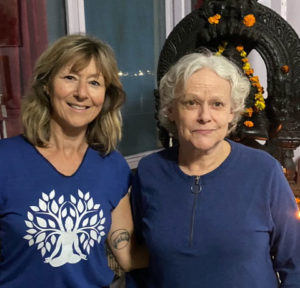Rishikesh – Holy city, holy cow!
by Jayne Lloyd-Jones
As I write, the evening puja, or Hindu religious ceremony, is in full swing across the river at the Parmarth Niketan. Each evening chanting fills our yoga room with waves of tabla drumming and invocations. From my bedroom on the second floor of the Omkarananda Ashram, above the yoga room, I look over the Ganges and across to the quieter eastern bank of the river. Our view takes in the brightly coloured ferries that whisk you across the Ganges for ten Rupees, the Ram Jhula footbridge (where pedestrians dodge scooters, monkeys and cows to connect to the other side) and many ‘pink palaces’ or brightly coloured temples and ashrams.
Rishikesh, located in the foothills of the Himalayas, is a magnet for spiritual seekers of all stripes: we’ve met older couples who’ve been coming each spring for 40 years; yoga students from all over the world; seekers and Sannyasins in search of themselves, the Truth… In the ATM queue, we met a yogi from Thetis Island, had dinner with a yoga teacher friend from Salt Spring Island, and spent time with Iyengar teacher Nancy Zrymiak and her husband Mike, from Vancouver.
Two large events have attracted many additional visitors this year. Mooji, an internationally known master philosopher, is giving a free ‘Satsang’ six days a week for a month. He has his own TV channel, Mooji TV, on YouTube, and is an excellent speaker on non-duality and the “Is-ness” of your heart. Then the Yoga Festival 2020, March 1-7, brings thousands to Rishikesh to experience world-class teachers, music, speakers and more.
In Rishikesh all the senses are bombarded: hawkers selling plastic orange bottles to capture Ganga water for temple rituals; the ubiquitous smell of Indian plumbing, combined with the splattered droppings of the many holy cows; and the scent of incense and flowers, as small children sell offerings for pilgrims to launch on the river with a prayer.
One Sunday we were up at 4am to see the sun rise from the Kunjapuri Temple, high up above Rishikesh. Sipping masala tea at dawn with views of India’s second highest peak, Ananda Devi, was spectacular. On the three-hour hike down with our mountaineer guide, we dropped in on a lively village wedding, to see the groom carried off to his bride in a palanquin the size of a large shoe box, and ended up at a waterfall where local boys were hoping we’d join them to splash around in the frigid water.

My Iyengar yoga intensive with Senior Iyengar teacher, Usha Devi, was the driving force behind our visit. Peter has found his own ashram and attends two yoga classes each day with a variety of Hatha Yoga teachers. He is learning pranayama, chanting invocations and tuneful Oms; has perfected the use of the morning neti pot, and rather wishes we were staying up the hill at the far more peaceful Niketan Ashram, where lawns and quiet courtyards replace the honking rickshaw hullabaloo that is our neighbourhood here at Omkarananda. Our room is simple, as befits most ashrams, but I am looking forward to sleeping in a comfortable bed again, and without the 9:30pm curfew and the 4am rickshaw symphony. (You can attend the intensive and stay elsewhere, but we opted to be ‘sur place’ this time.)
As for my yoga intensive, it has been just that – intense! Usha Devi studied with BKS Iyengar and his daughter Geeta Iyengar, for many years. She manages to distill their teachings in a fiery delivery, yet with a good pinch of humour. She brooks no excuses and has no patience for weakness. Thirty-four hours of teaching, lectures and self-practice over eight days have given us moments of elation, exasperation, humility and a chance to reflect on areas for improvement.
Her personal story of immense hardship explains a great deal. She recovered miraculously from two severe car accidents (six months in hospital, two years in plaster casts, then a second accident, which fractured both her femurs) with help from Guruji. Her personal recovery has left her with a deep empathy with her students. Thirty-four hours of teaching, lectures, pranayama and self-practice over eight days have given us moments of elation, exasperation, humility and in the end the chance to reflect on areas for improvement.
That’s the outline of the workshop. But I already hear you asking for more detail. So, here is the juice. The first thing she did was to have everyone lengthen his or her dog pose by about 6 inches! “Why are you taking Uttanasana when I said Adho Mukha Svanasana? Take the legs back, more, more, MORE! You with the polka dot bloomers, (that was me!) are you listening?” So now a 5-min downward dog in a 6-inch wider stance – tough? Oh yes.
Usha has the appearance of an unassuming Swiss grandmother. However, her ability to reduce people to a trembling mass of wobbling arms and legs is legendary. Her cries of “What’s HAPPening?” “ Lift your thighs, lift your thighs, I say”, reverberate around the yoga hall. She believes in long holds and accepts no one coming out of a pose before she says so.
Most classes began with a 5-minute Utthanasana, then a 5-minute Adho Mukha Svanasana; then (after the first couple of days when the focus shifted from the knees,) she switched her emphasis to inversions and followed with a 5-minute Sirsasana I, with multiple variations; then a 5-minute Sirsasana II. And this was just the warm-up. Invariably she had us doing preparations for elbow balance or Urdhva Dhanurasana, with multiple renditions of arm balance (10 times each leg). Along the way there were long, long holds in Supta Virasana (no props), Viparita Dandasana, Vasisthasana and Kasyapasana. By day three we were in Bhujapidasana, Tittibhasana, Kurmasana, and more. Oh my goodness.
She has a way of wringing a lot out of her students who want to work hard for her, and who return year after year. Her Swiss/Indian manner of speech often left me chuckling. “Nussing is HAPPening! Thighs UP, thighs UP!, I say. Can’t you understand English? Are these your knees or the Ram Jhula Bridge? You all want to sleep, isn’t it?” Shades of Geetaji here, no doubt about it.
We also had a lecture from Siddharta on the Vedas twice a week. Turns out that Siddharta is Usha’s son – I had no idea!
So Usha has given me plenty to think about – both for myself and for my students. Her strict manner belies a passion for teaching Guruji’s work and leaves no room for the ego. But there is a twinkle in her eye and warmth that is unmistakable, when class is over. And, yes, I am working on my arms and shoulders every day and am grateful to have had the chance to study with Usha.
Rishikesh remains a magnet for its exuberance and spirituality. We may be drawn back (to an ashram with a more comfortable bed!)

